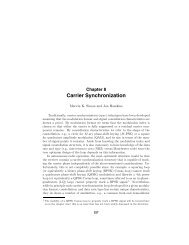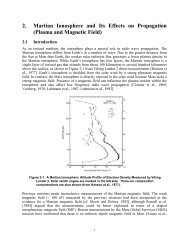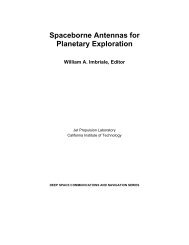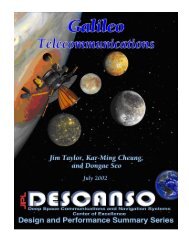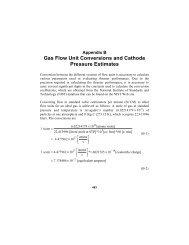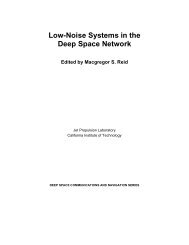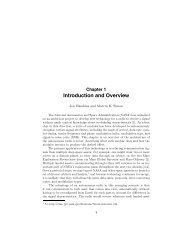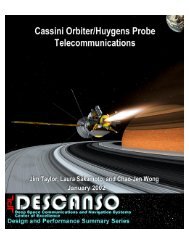Propagation Effects Handbook for Satellite Systems - DESCANSO ...
Propagation Effects Handbook for Satellite Systems - DESCANSO ...
Propagation Effects Handbook for Satellite Systems - DESCANSO ...
Create successful ePaper yourself
Turn your PDF publications into a flip-book with our unique Google optimized e-Paper software.
● For each hour’s observations, the attenuation of each reported<br />
cloud layer (up to four) was calculated based on the layer’s”<br />
water particle densityr thickness, and temperature. The<br />
attenuation due to water vapor and oxygen was also found using<br />
the reported surface conditions.<br />
. Total attenuation and noise temperature due to all cloud<br />
layers and gases were calculated <strong>for</strong> sixteen possible cloud<br />
configurations, corresponding to all combinations of cloud<br />
presence or absence at the four layer heights.<br />
. Cumulative probability distributions <strong>for</strong> attenuation and noise<br />
temperature were calculated using the reported percentcoverage<br />
values corresponding to each cloud layer. For<br />
example, if the percentage of coverage was 60 percent <strong>for</strong><br />
layer 1 and 20 percent <strong>for</strong> layer 2, then the probability of<br />
various configurations of clouds present in the antenna beam<br />
would be as follows:<br />
no clouds present: (l-.6) (1-02) = 0.32<br />
layer 1 clouds only present: (06) (l-.2) = 0.48<br />
layer 2 clouds only present: (l-.6) (.2) = 0.08<br />
clouds in both layers present: (.6) (.2) = 0.12<br />
Typical cumulative attenuation and noise temperature<br />
distributions calculated in this way are shown in Figure 6.4-3. The<br />
curves apply to zenith paths only, but can be extended to slant<br />
paths using a cosecant law. Such extension will probably lead to<br />
overestimation at low elevation angles and small time percentages.<br />
This is because clouds with large vertical development have less<br />
thickness <strong>for</strong> slant paths than <strong>for</strong> zenith paths. At time<br />
percentages where rain effects become significant (cumulative<br />
distributions greater than 95%)/ the attenuation and noise<br />
temperature due to the rain should be considered also.<br />
6-69





